Developing Event Safety Risk Typology: A Qualitative Study Report
VerifiedAdded on 2023/06/15
|8
|1625
|470
Report
AI Summary
This report presents a research proposal focused on developing an event safety risk typology through a qualitative study of risk perception among event planners and venue managers in the United Kingdom. The research aims to explore the meaning and concept of event safety risk, analyze challenges of event safety in organizations, and recommend strategies to eliminate event risks. It employs an interpretivism philosophy and an inductive approach, utilizing a mixed research design with both primary (survey through questionnaire) and secondary data collection methods (literature review). The research strategy involves survey questionnaires and literature review. Data analysis will be conducted using MS-Excel for numerical data and literature review for theoretical data. The research adheres to ethical considerations, ensuring confidentiality and avoiding plagiarism. The timetable outlines the estimated time for various research activities, from objective design to final submission. Desklib provides access to similar research reports and solved assignments to aid students in their studies.
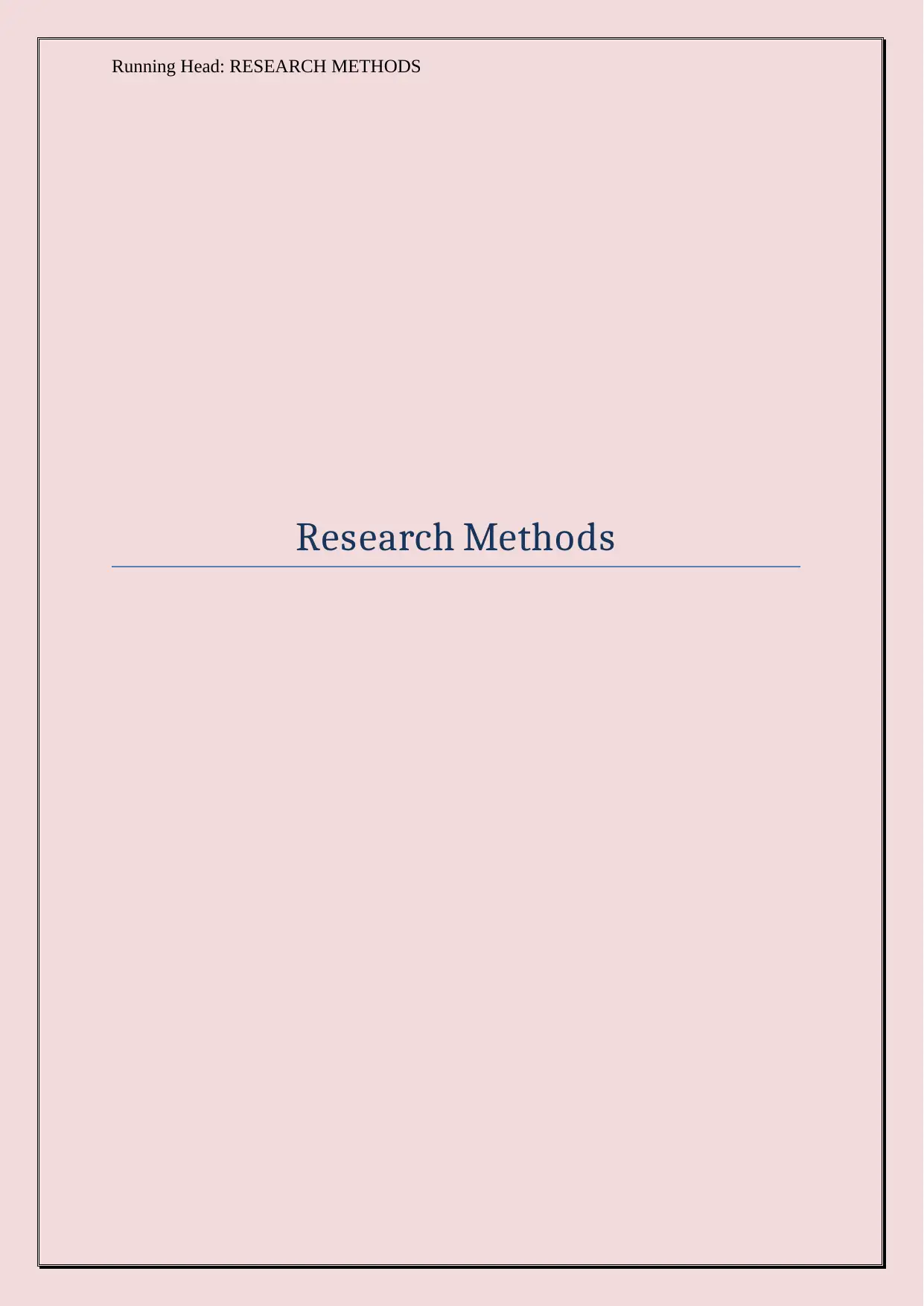
Running Head: RESEARCH METHODS
Research Methods
Research Methods
Paraphrase This Document
Need a fresh take? Get an instant paraphrase of this document with our AI Paraphraser
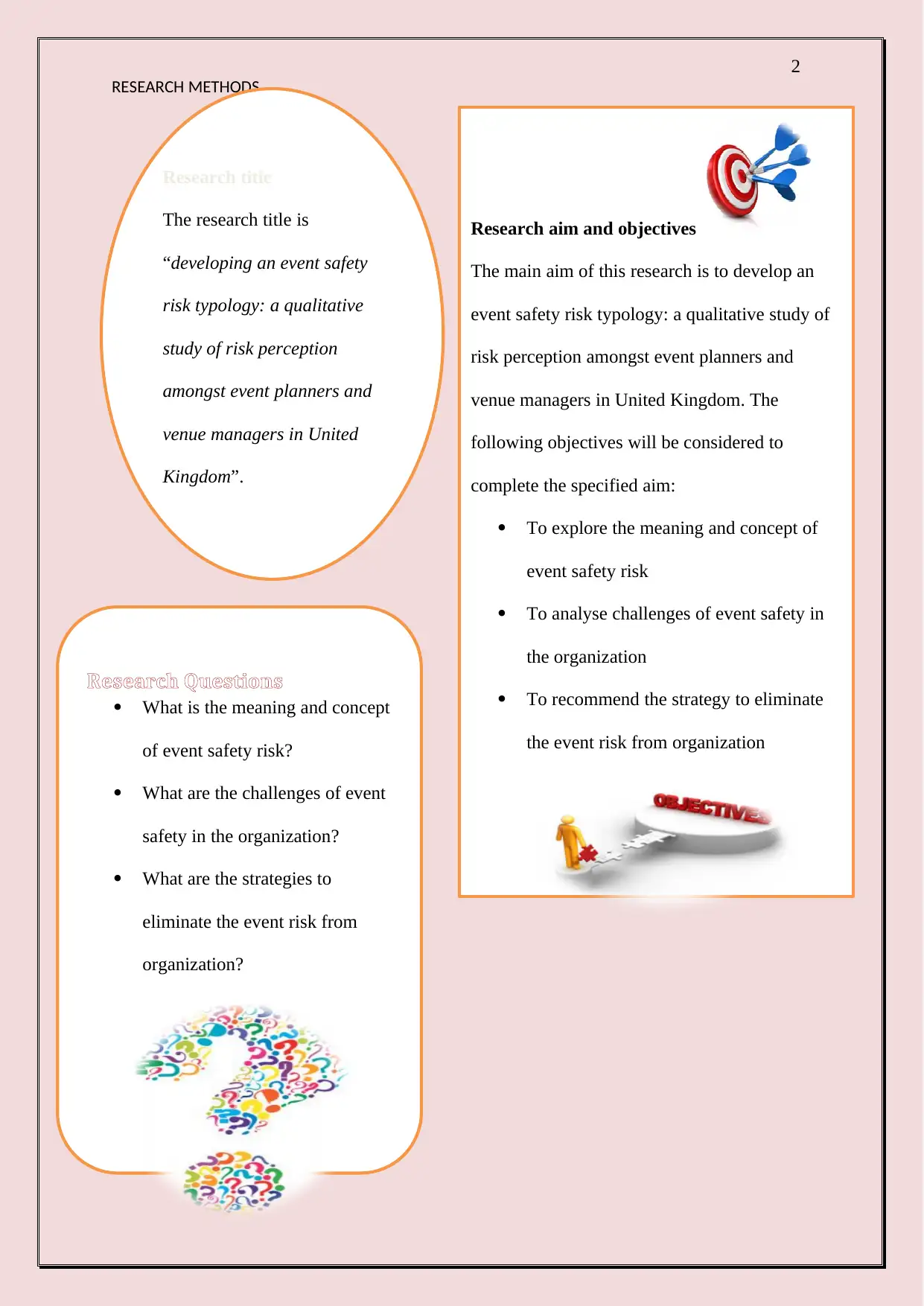
2
RESEARCH METHODS
Research title
The research title is
“developing an event safety
risk typology: a qualitative
study of risk perception
amongst event planners and
venue managers in United
Kingdom”.
Research aim and objectives
The main aim of this research is to develop an
event safety risk typology: a qualitative study of
risk perception amongst event planners and
venue managers in United Kingdom. The
following objectives will be considered to
complete the specified aim:
To explore the meaning and concept of
event safety risk
To analyse challenges of event safety in
the organization
To recommend the strategy to eliminate
the event risk from organization
Research Questions
What is the meaning and concept
of event safety risk?
What are the challenges of event
safety in the organization?
What are the strategies to
eliminate the event risk from
organization?
RESEARCH METHODS
Research title
The research title is
“developing an event safety
risk typology: a qualitative
study of risk perception
amongst event planners and
venue managers in United
Kingdom”.
Research aim and objectives
The main aim of this research is to develop an
event safety risk typology: a qualitative study of
risk perception amongst event planners and
venue managers in United Kingdom. The
following objectives will be considered to
complete the specified aim:
To explore the meaning and concept of
event safety risk
To analyse challenges of event safety in
the organization
To recommend the strategy to eliminate
the event risk from organization
Research Questions
What is the meaning and concept
of event safety risk?
What are the challenges of event
safety in the organization?
What are the strategies to
eliminate the event risk from
organization?
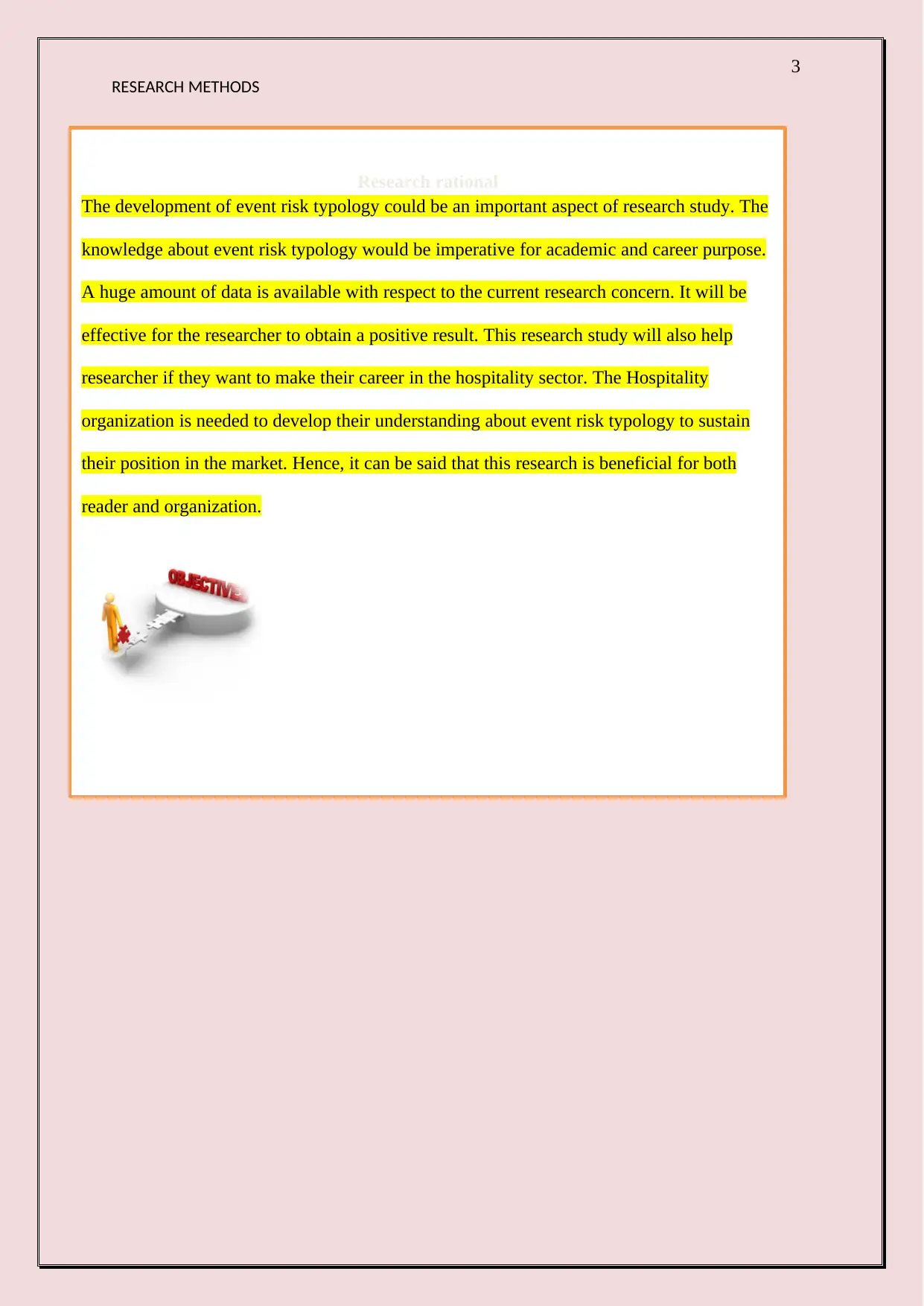
3
RESEARCH METHODS
Research rational
The development of event risk typology could be an important aspect of research study. The
knowledge about event risk typology would be imperative for academic and career purpose.
A huge amount of data is available with respect to the current research concern. It will be
effective for the researcher to obtain a positive result. This research study will also help
researcher if they want to make their career in the hospitality sector. The Hospitality
organization is needed to develop their understanding about event risk typology to sustain
their position in the market. Hence, it can be said that this research is beneficial for both
reader and organization.
RESEARCH METHODS
Research rational
The development of event risk typology could be an important aspect of research study. The
knowledge about event risk typology would be imperative for academic and career purpose.
A huge amount of data is available with respect to the current research concern. It will be
effective for the researcher to obtain a positive result. This research study will also help
researcher if they want to make their career in the hospitality sector. The Hospitality
organization is needed to develop their understanding about event risk typology to sustain
their position in the market. Hence, it can be said that this research is beneficial for both
reader and organization.
⊘ This is a preview!⊘
Do you want full access?
Subscribe today to unlock all pages.

Trusted by 1+ million students worldwide
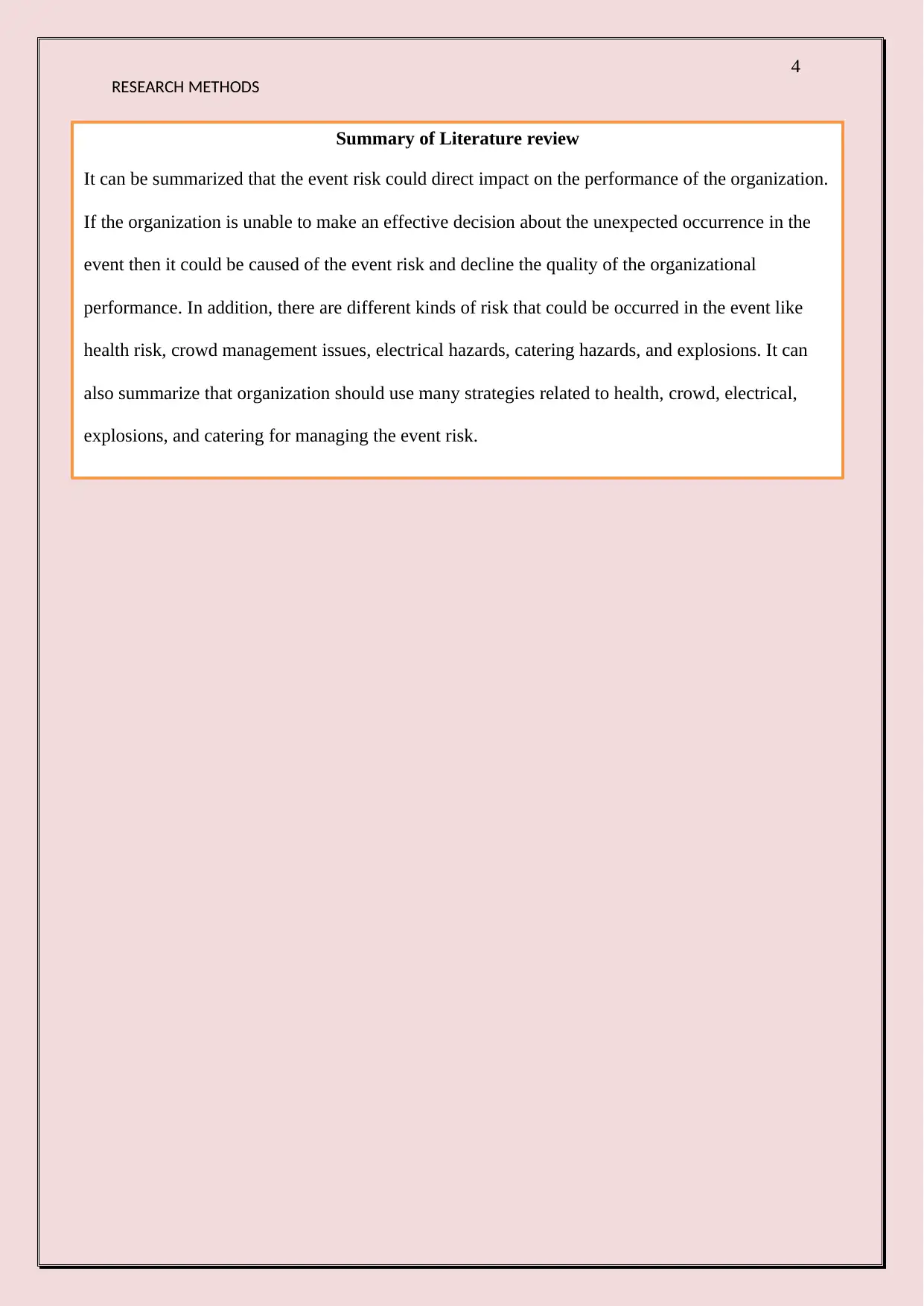
4
RESEARCH METHODS
Summary of Literature review
It can be summarized that the event risk could direct impact on the performance of the organization.
If the organization is unable to make an effective decision about the unexpected occurrence in the
event then it could be caused of the event risk and decline the quality of the organizational
performance. In addition, there are different kinds of risk that could be occurred in the event like
health risk, crowd management issues, electrical hazards, catering hazards, and explosions. It can
also summarize that organization should use many strategies related to health, crowd, electrical,
explosions, and catering for managing the event risk.
RESEARCH METHODS
Summary of Literature review
It can be summarized that the event risk could direct impact on the performance of the organization.
If the organization is unable to make an effective decision about the unexpected occurrence in the
event then it could be caused of the event risk and decline the quality of the organizational
performance. In addition, there are different kinds of risk that could be occurred in the event like
health risk, crowd management issues, electrical hazards, catering hazards, and explosions. It can
also summarize that organization should use many strategies related to health, crowd, electrical,
explosions, and catering for managing the event risk.
Paraphrase This Document
Need a fresh take? Get an instant paraphrase of this document with our AI Paraphraser
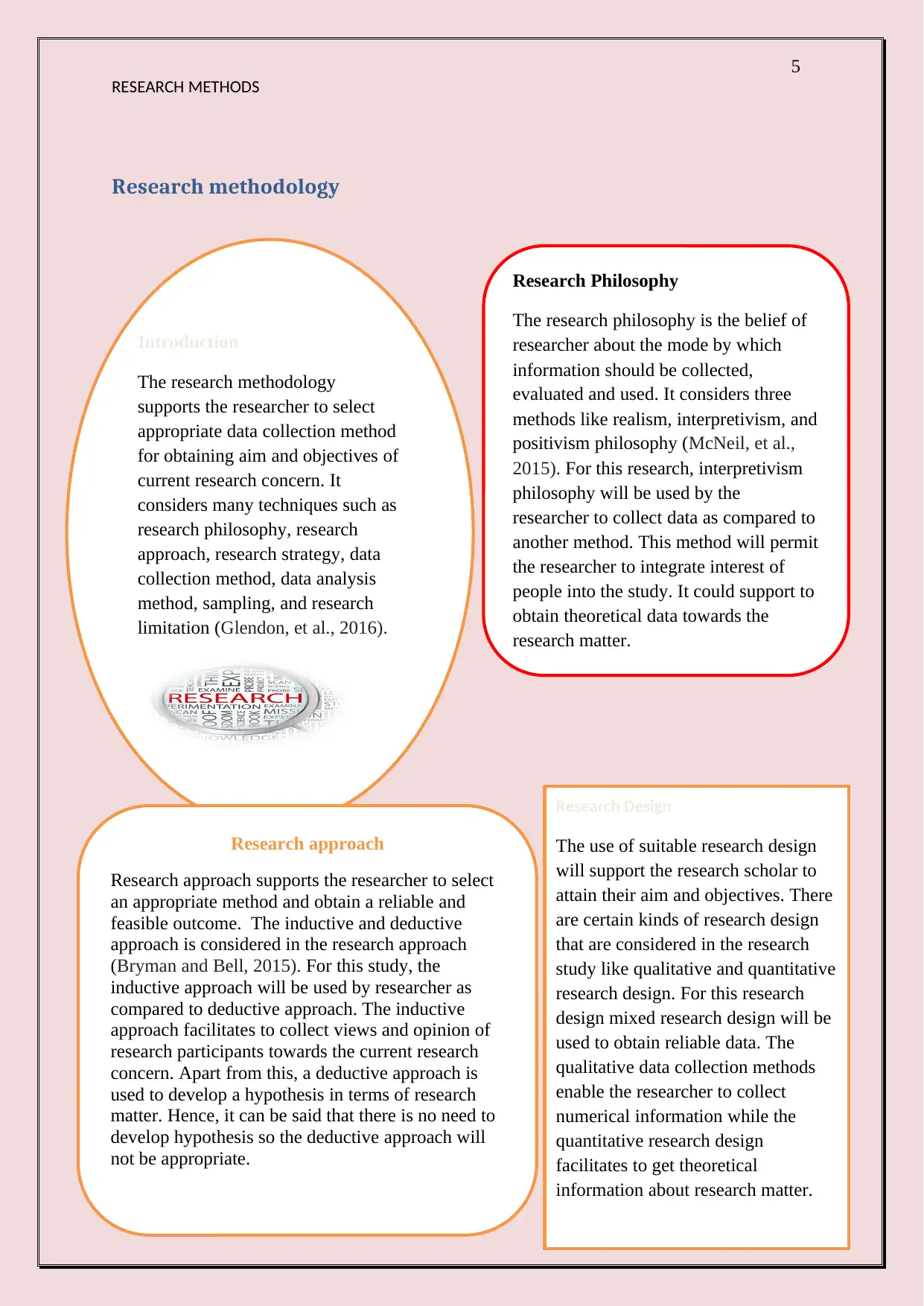
5
RESEARCH METHODS
Research methodology
Introduction
The research methodology
supports the researcher to select
appropriate data collection method
for obtaining aim and objectives of
current research concern. It
considers many techniques such as
research philosophy, research
approach, research strategy, data
collection method, data analysis
method, sampling, and research
limitation (Glendon, et al., 2016).
Research Philosophy
The research philosophy is the belief of
researcher about the mode by which
information should be collected,
evaluated and used. It considers three
methods like realism, interpretivism, and
positivism philosophy (McNeil, et al.,
2015). For this research, interpretivism
philosophy will be used by the
researcher to collect data as compared to
another method. This method will permit
the researcher to integrate interest of
people into the study. It could support to
obtain theoretical data towards the
research matter.
Research approach
Research approach supports the researcher to select
an appropriate method and obtain a reliable and
feasible outcome. The inductive and deductive
approach is considered in the research approach
(Bryman and Bell, 2015). For this study, the
inductive approach will be used by researcher as
compared to deductive approach. The inductive
approach facilitates to collect views and opinion of
research participants towards the current research
concern. Apart from this, a deductive approach is
used to develop a hypothesis in terms of research
matter. Hence, it can be said that there is no need to
develop hypothesis so the deductive approach will
not be appropriate.
Research Design
The use of suitable research design
will support the research scholar to
attain their aim and objectives. There
are certain kinds of research design
that are considered in the research
study like qualitative and quantitative
research design. For this research
design mixed research design will be
used to obtain reliable data. The
qualitative data collection methods
enable the researcher to collect
numerical information while the
quantitative research design
facilitates to get theoretical
information about research matter.
RESEARCH METHODS
Research methodology
Introduction
The research methodology
supports the researcher to select
appropriate data collection method
for obtaining aim and objectives of
current research concern. It
considers many techniques such as
research philosophy, research
approach, research strategy, data
collection method, data analysis
method, sampling, and research
limitation (Glendon, et al., 2016).
Research Philosophy
The research philosophy is the belief of
researcher about the mode by which
information should be collected,
evaluated and used. It considers three
methods like realism, interpretivism, and
positivism philosophy (McNeil, et al.,
2015). For this research, interpretivism
philosophy will be used by the
researcher to collect data as compared to
another method. This method will permit
the researcher to integrate interest of
people into the study. It could support to
obtain theoretical data towards the
research matter.
Research approach
Research approach supports the researcher to select
an appropriate method and obtain a reliable and
feasible outcome. The inductive and deductive
approach is considered in the research approach
(Bryman and Bell, 2015). For this study, the
inductive approach will be used by researcher as
compared to deductive approach. The inductive
approach facilitates to collect views and opinion of
research participants towards the current research
concern. Apart from this, a deductive approach is
used to develop a hypothesis in terms of research
matter. Hence, it can be said that there is no need to
develop hypothesis so the deductive approach will
not be appropriate.
Research Design
The use of suitable research design
will support the research scholar to
attain their aim and objectives. There
are certain kinds of research design
that are considered in the research
study like qualitative and quantitative
research design. For this research
design mixed research design will be
used to obtain reliable data. The
qualitative data collection methods
enable the researcher to collect
numerical information while the
quantitative research design
facilitates to get theoretical
information about research matter.

6
RESEARCH METHODS
Research Strategy
The research strategy is
imperative to address
relevant data towards the
research issues by
considering many
methods like survey
through questionnaire,
literature review, case
study, interview method,
and focus group
(Silverman, 2016). In this
research study, survey
through questionnaire and
literature review method
is used by the researcher
to get a positive result.
Data collection method
The data collection method supports the researcher
to select appropriate method in the context of
research matter. There are two kinds of methods
like primary and secondary data collection method.
The primary data collection method enables to
collect fresh data towards the research concern.
Apart from this, the secondary data collection
method support to obtain data from existing
information. The primary data collection method
considers many sources to collect reliable data like
observation, survey through a questionnaire, and
interview method (Haimes, 2015). Secondary data
is collected from many sources like academic
journals, books, and online and offline sources. For
this study, both primary and secondary data
collection method is used by the researcher to
obtain reliable information in the context of
research matter. For this study, researcher will use
survey through questionnaire method to collect the
primary data while journals, magazines, books, and
online data will be used to collect the secondary
data.
Sampling Method
Sampling method enables the researcher to choose appropriate sample size for
conducting their research. Probability and non-probability sampling method is
considered in the research study (Flick, 2015). For this research study, probability
sampling method is used by researcher rather than non-probability sampling method.
Since, this method enables to select participant on a random basis that will eliminate the
biases form the research study.
RESEARCH METHODS
Research Strategy
The research strategy is
imperative to address
relevant data towards the
research issues by
considering many
methods like survey
through questionnaire,
literature review, case
study, interview method,
and focus group
(Silverman, 2016). In this
research study, survey
through questionnaire and
literature review method
is used by the researcher
to get a positive result.
Data collection method
The data collection method supports the researcher
to select appropriate method in the context of
research matter. There are two kinds of methods
like primary and secondary data collection method.
The primary data collection method enables to
collect fresh data towards the research concern.
Apart from this, the secondary data collection
method support to obtain data from existing
information. The primary data collection method
considers many sources to collect reliable data like
observation, survey through a questionnaire, and
interview method (Haimes, 2015). Secondary data
is collected from many sources like academic
journals, books, and online and offline sources. For
this study, both primary and secondary data
collection method is used by the researcher to
obtain reliable information in the context of
research matter. For this study, researcher will use
survey through questionnaire method to collect the
primary data while journals, magazines, books, and
online data will be used to collect the secondary
data.
Sampling Method
Sampling method enables the researcher to choose appropriate sample size for
conducting their research. Probability and non-probability sampling method is
considered in the research study (Flick, 2015). For this research study, probability
sampling method is used by researcher rather than non-probability sampling method.
Since, this method enables to select participant on a random basis that will eliminate the
biases form the research study.
⊘ This is a preview!⊘
Do you want full access?
Subscribe today to unlock all pages.

Trusted by 1+ million students worldwide
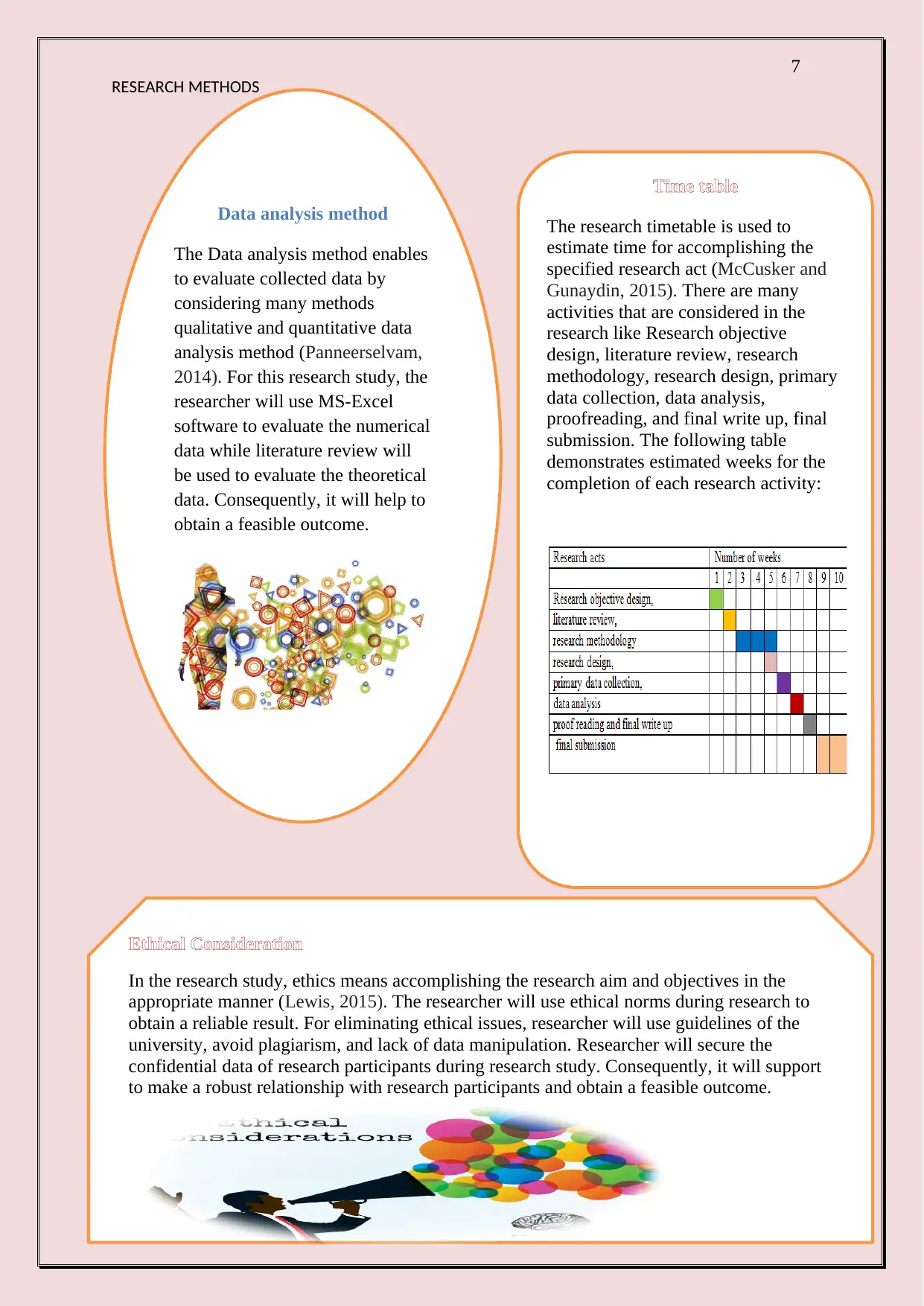
7
RESEARCH METHODS
Data analysis method
The Data analysis method enables
to evaluate collected data by
considering many methods
qualitative and quantitative data
analysis method (Panneerselvam,
2014). For this research study, the
researcher will use MS-Excel
software to evaluate the numerical
data while literature review will
be used to evaluate the theoretical
data. Consequently, it will help to
obtain a feasible outcome.
Ethical Consideration
In the research study, ethics means accomplishing the research aim and objectives in the
appropriate manner (Lewis, 2015). The researcher will use ethical norms during research to
obtain a reliable result. For eliminating ethical issues, researcher will use guidelines of the
university, avoid plagiarism, and lack of data manipulation. Researcher will secure the
confidential data of research participants during research study. Consequently, it will support
to make a robust relationship with research participants and obtain a feasible outcome.
Time table
The research timetable is used to
estimate time for accomplishing the
specified research act (McCusker and
Gunaydin, 2015). There are many
activities that are considered in the
research like Research objective
design, literature review, research
methodology, research design, primary
data collection, data analysis,
proofreading, and final write up, final
submission. The following table
demonstrates estimated weeks for the
completion of each research activity:
RESEARCH METHODS
Data analysis method
The Data analysis method enables
to evaluate collected data by
considering many methods
qualitative and quantitative data
analysis method (Panneerselvam,
2014). For this research study, the
researcher will use MS-Excel
software to evaluate the numerical
data while literature review will
be used to evaluate the theoretical
data. Consequently, it will help to
obtain a feasible outcome.
Ethical Consideration
In the research study, ethics means accomplishing the research aim and objectives in the
appropriate manner (Lewis, 2015). The researcher will use ethical norms during research to
obtain a reliable result. For eliminating ethical issues, researcher will use guidelines of the
university, avoid plagiarism, and lack of data manipulation. Researcher will secure the
confidential data of research participants during research study. Consequently, it will support
to make a robust relationship with research participants and obtain a feasible outcome.
Time table
The research timetable is used to
estimate time for accomplishing the
specified research act (McCusker and
Gunaydin, 2015). There are many
activities that are considered in the
research like Research objective
design, literature review, research
methodology, research design, primary
data collection, data analysis,
proofreading, and final write up, final
submission. The following table
demonstrates estimated weeks for the
completion of each research activity:
Paraphrase This Document
Need a fresh take? Get an instant paraphrase of this document with our AI Paraphraser
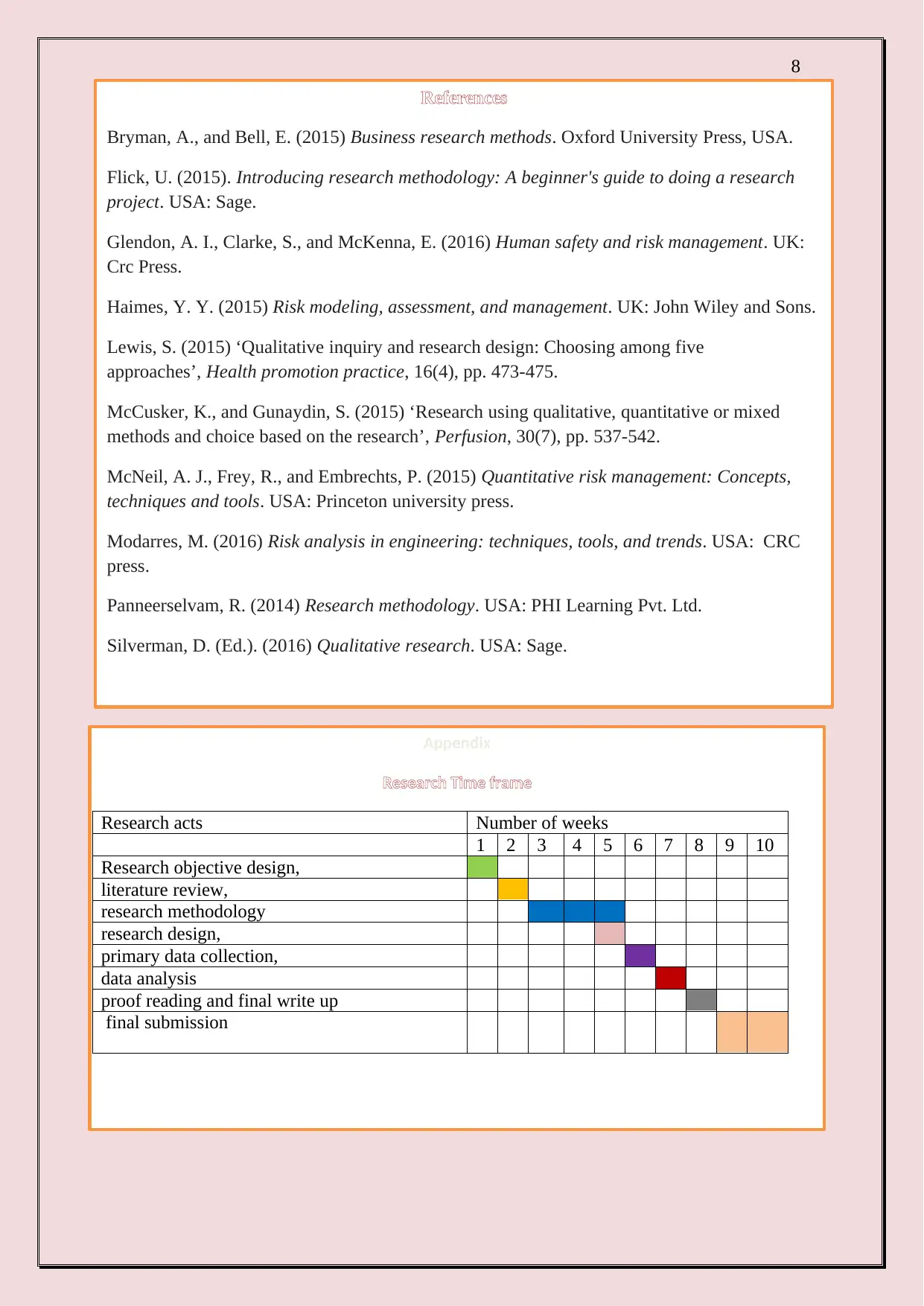
8
RESEARCH METHODS References
Bryman, A., and Bell, E. (2015) Business research methods. Oxford University Press, USA.
Flick, U. (2015). Introducing research methodology: A beginner's guide to doing a research
project. USA: Sage.
Glendon, A. I., Clarke, S., and McKenna, E. (2016) Human safety and risk management. UK:
Crc Press.
Haimes, Y. Y. (2015) Risk modeling, assessment, and management. UK: John Wiley and Sons.
Lewis, S. (2015) ‘Qualitative inquiry and research design: Choosing among five
approaches’, Health promotion practice, 16(4), pp. 473-475.
McCusker, K., and Gunaydin, S. (2015) ‘Research using qualitative, quantitative or mixed
methods and choice based on the research’, Perfusion, 30(7), pp. 537-542.
McNeil, A. J., Frey, R., and Embrechts, P. (2015) Quantitative risk management: Concepts,
techniques and tools. USA: Princeton university press.
Modarres, M. (2016) Risk analysis in engineering: techniques, tools, and trends. USA: CRC
press.
Panneerselvam, R. (2014) Research methodology. USA: PHI Learning Pvt. Ltd.
Silverman, D. (Ed.). (2016) Qualitative research. USA: Sage.
Appendix
Research Time frame
Research acts Number of weeks
1 2 3 4 5 6 7 8 9 10
Research objective design,
literature review,
research methodology
research design,
primary data collection,
data analysis
proof reading and final write up
final submission
RESEARCH METHODS References
Bryman, A., and Bell, E. (2015) Business research methods. Oxford University Press, USA.
Flick, U. (2015). Introducing research methodology: A beginner's guide to doing a research
project. USA: Sage.
Glendon, A. I., Clarke, S., and McKenna, E. (2016) Human safety and risk management. UK:
Crc Press.
Haimes, Y. Y. (2015) Risk modeling, assessment, and management. UK: John Wiley and Sons.
Lewis, S. (2015) ‘Qualitative inquiry and research design: Choosing among five
approaches’, Health promotion practice, 16(4), pp. 473-475.
McCusker, K., and Gunaydin, S. (2015) ‘Research using qualitative, quantitative or mixed
methods and choice based on the research’, Perfusion, 30(7), pp. 537-542.
McNeil, A. J., Frey, R., and Embrechts, P. (2015) Quantitative risk management: Concepts,
techniques and tools. USA: Princeton university press.
Modarres, M. (2016) Risk analysis in engineering: techniques, tools, and trends. USA: CRC
press.
Panneerselvam, R. (2014) Research methodology. USA: PHI Learning Pvt. Ltd.
Silverman, D. (Ed.). (2016) Qualitative research. USA: Sage.
Appendix
Research Time frame
Research acts Number of weeks
1 2 3 4 5 6 7 8 9 10
Research objective design,
literature review,
research methodology
research design,
primary data collection,
data analysis
proof reading and final write up
final submission
1 out of 8
Related Documents
Your All-in-One AI-Powered Toolkit for Academic Success.
+13062052269
info@desklib.com
Available 24*7 on WhatsApp / Email
![[object Object]](/_next/static/media/star-bottom.7253800d.svg)
Unlock your academic potential
Copyright © 2020–2025 A2Z Services. All Rights Reserved. Developed and managed by ZUCOL.



